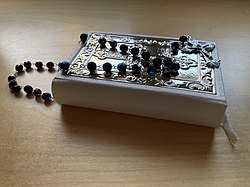
Summary
Anglican prayer beads, also known as the Anglican rosary or Anglican chaplet, are a loop of strung Christian prayer beads used chiefly by Anglicans in the Anglican Communion, as well as by communicants in the Anglican Continuum. This Anglican devotion has spread to other Christian denominations, including Methodists and the Reformed.[1][2]


Description edit
Anglican prayer bead sets consist of a cross and thirty-three beads.
Beads edit
The loop is formed of thirty-two beads. Twenty-eight of the beads are divided into four groups consisting of seven beads, each which are called "weeks". The four larger beads separating the four groups are called "cruciform" beads. When the loop of an Anglican prayer bead set is opened into a circular shape, the "cruciform" beads form the points of a cross within the circle of the set, hence the term. Next after the cross on Anglican prayer bead sets is a single bead called the "invitatory" bead, which brings the total of beads to thirty-three.
Materials edit
The beads used can be made of a variety of materials, such as precious stones, wood, coloured glass, or even dried and painted seeds.
Symbolism edit
The number thirty-three signifies the number of years that Jesus Christ lived on the Earth, while the number seven signifies wholeness or completion in the faith, the days of creation, and the seasons of the Church year.[3]
Cross edit
Anglican prayer bead sets are made with a variety of crosses or, occasionally, crucifixes. Christian crosses such as the Celtic cross and the San Damiano cross are two which are often used, though other styles are used too.
Prayer edit
Anglican prayer beads are most often used as a tactile aid to prayer and as a counting device. The standard Anglican set consists of the following pattern, starting with the cross, followed by the Invitatory Bead, and subsequently, the first Cruciform bead, moving to the right, through the first set of seven beads to the next Cruciform bead, continuing around the circle. He or she may conclude by saying the Lord's Prayer on the invitatory bead or a final prayer on the cross as in the examples below. The entire circle may be done thrice, which signifies the lifetime of Jesus Christ and the Holy Trinity.[3]
The Cross
In the Name of God, Father, Son, and Holy Spirit. Amen.
The Invitatory
O God make speed to save me (us),
O Lord make haste to help me (us),
Glory to the Father, and to the Son, and to the Holy Spirit: As it was in the beginning, is now, and will be forever. Amen.
The Cruciforms
Holy God,
Holy Almighty,
Holy Immortal One,
Have mercy upon me (us).
The Weeks
Lord Jesus Christ, Son of God,
Have mercy on me, a sinner.
The Lord's Prayer
Our Father, who art in heaven,
hallowed be thy Name,
thy kingdom come, thy will be done,
on earth as it is in heaven.
Give us this day our daily bread.
And forgive us our trespasses,
as we forgive those who trespass against us.
And lead us not into temptation,
but deliver us from evil.
For thine is the kingdom,
and the power, and the glory,
forever and ever. Amen.
The Cross
I bless the Lord.
(Let us bless the Lord
Thanks be to God.)[4]
See also edit
Notes edit
- ^ Vincent, Kristen E. (1 March 2017). Beads of Healing: Prayer, Trauma, and Spiritual Wholeness. Upper Room. pp. 11–12. ISBN 9780835816373.
- ^ Walsh, Fran (20 April 2016). "Prayer Beads for United Methodists". The United Methodist Church. Retrieved 11 March 2017.
At the United Methodist General Conference, every delegate and church leader received a set of prayer beads made especially for 2016 in Portland. The United Methodist artist who helped craft the design says Protestant prayer beads are an idea that is catching on.
- ^ a b "Anglican Prayer Beads". King of Peace Episcopal Church. Archived from the original on 2019-02-01. Retrieved 2007-10-18.
- ^ "Trisagion and Jesus Prayer". King of Peace Episcopal Church. Retrieved 2007-10-18.
Bibliography edit
Further reading edit
- Crosby, Gilbert T. (2000). Praying the Rosary: An Introduction for Episcopalians. Cincinnati, Ohio: Forward Movement Publications. OCLC 48854131.
- Durrad, W. J. The Anglican Use of the Rosary. London: A. H. Stockwell. OCLC 36764926.
- Elliott, Kristin M.; Seibt, Betty Kay (2001). Holding Your Prayers in Your Hands: Praying the Anglican Rosary (10th ed.). Denton, Texas: Open Hands. OCLC 229217288.
- Price, Anthony (1991). Reconsidering the Rosary. Grove Spirituality Series. Vol. 36. Bramcote, England: Grove Books. ISBN 978-1-85174-170-0.
- Smith, Charles (1969). The Rosary. London: League of Anglican Loyalists. ISBN 978-0-900894-08-4.
- Society of St. John the Evangelist, ed. (1975). The Mysteries of the Rosary: A Short Treatise. London: Church Literature Association. OCLC 2031861.
- Stowell, Renata (2004). The Anglican Rosary for Children: Prayers for the Young at Heart. Kelowna, British Columbia. ISBN 978-0-9735332-1-7.
{{cite book}}: CS1 maint: location missing publisher (link) - Vincent, Kristen E. (2013). A Bead and a Prayer: A Beginner's Guide to Protestant Prayer Beads. Nashville, Tennessee: Upper Room Books. ISBN 978-0-8358-1217-7.
- Winston, Kimberly (2008). Bead One, Pray, Too: A Guide to Making and Using Prayer Beads. Harrisburg, Pennsylvania: Morehouse Publishing. ISBN 978-0-8192-2276-3.
External links edit
- Christian Prayer Beads Central
- Anglican Prayer Beads Archived 2010-12-19 at the Wayback Machine
- History of Prayer Beads


